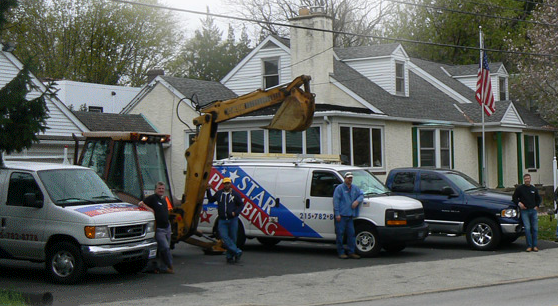What Happens If Your Attic Is Not Vented? – Understanding the Risks
If an attic is not vented, it can lead to a variety of problems. The lack of ventilation can cause moisture to become trapped in the attic, leading to mold growth, water damage and even structural damage. In addition, it can cause the temperature within the attic to rise significantly, leading to higher energy bills. Furthermore, not venting an attic can prevent proper insulation from working effectively, which reduces the energy efficiency of a home. To prevent these issues, homeowners should ensure that their attics are properly ventilated with soffit vents and ridge vents.
What is Necessary to Vent an Attic?
Ventilation of an attic is essential for a properly functioning roof system and overall home performance. It helps maintain the structural integrity of the roof, prevents condensation and moisture damage, and helps preserve the energy efficiency of the property. Proper ventilation also ensures that the attic space doesn’t become too hot during summer months, compromising insulation and other components in the attic space. To achieve proper ventilation, there are a few things that need to be considered: types of vents, regions requiring attic ventilation, and benefits of proper ventilation.
Types of Attic Vents
There are two main types of attic vents: intake vents which allow air to enter the attic space, and exhaust vents which allow air to leave. Intake vents are typically located near the eaves or lower sections of a roof while exhaust vents are usually located near the ridge or higher sections. Both types should be used to ensure proper airflow throughout the entire attic space – though depending on climate differences in different regions, one type may be more important than another.
Regions Requiring Attic Ventilation
Ventilation requirements vary depending on region and climate – but generally speaking, most regions require at least some form of ventilation in their attics. The amount required will depend largely on temperature fluctuations throughout the year as well as climate conditions such as high humidity levels or heavy rainfall. In general however, it’s recommended that at least one square foot (0.093 square metres) of net free vent area be installed for every 300 square feet (27.9 square metres) of floor area in an attic space in order to ensure adequate airflow.
Benefits of Proper Ventilation
In addition to preventing condensation build up in attics caused by temperature fluctuations throughout the year, proper ventilation can also help improve energy efficiency within a home by allowing hot air to escape from attics during summer months and cooler air to enter during winter months – thus reducing reliance on heating/cooling systems which can help reduce energy bills over time. Furthermore, adequate airflow can help protect insulation from degrading over time due to temperatures fluctuating too much within an attic space as well as protecting roof sheathing from moisture damage caused by condensation build-up within an inadequately ventilated attic.
Danger Of Poor Ventilation
Inadequate ventilation can have serious consequences for both a property’s structure and its systems – including increased risk of condensation build-up which can lead to moisture damage within attics as well as compromised insulation performance which reduces energy efficiency throughout a home. Poorly ventilated attics can also cause damage to roof sheathing due to excessive heat buildup as well as compromising structural integrity due to increased risk of rot caused by moisture accumulation over time if left unchecked.
Reasons for Inadequate Attic Ventilation
In some cases inadequate ventilation is simply down poor design or installation – often resulting in insufficient intake or exhaust vents being installed or incorrectly positioned relative to each other so that adequate airflow cannot be achieved between them both – but this is not always the case however; wear over time caused by weathering conditions such as high winds or pest infestations can often obstruct intake/exhaust vents resulting in inadequate airflow; while lack of maintenance or cleaning over time can also prevent intakes/exhausts from functioning properly even if they have been correctly positioned relative one another when initially installed
Impact On Home System Components
Poorly ventilated attics can cause serious problems with home system components such as furnaces and HVAC equipment overheating due increased temperatures within attics; they can also cause structural compromise within roofs due weakened beams/deteriorated shingles caused by excess moisture accumulation over time; while electrical installations within an unventilated attic space may also increase threat fire hazards due excessive heat buildup over extended periods if left unchecked
Prevention Measures To Maintain Adequate Ventilation In The Attic
In order maintain adequate ventilation it’s important perform regular maintenance checks on intake/exhaust vents ensuring that they remain free from obstruction such debris build up; it’s also important ensure all intake/exhausts continue working properly any necessary repairs being made immediately where possible; finally it’s advisable keep any insulation material away from intakes/exhausts ensuring that air flow isn’t obstructed this way either further improving overall performance within an attic space
What Happens If Attic Is Not Vented?
When an attic is not properly vented, it can have serious consequences on the home. Without proper ventilation, the hot air will be trapped inside the attic, leading to an increase in temperature that can cause the roof materials to expand and contract. This expansion and contraction can cause damage to the roofing material and make it more susceptible to leaks. In addition, without proper ventilation, moisture will build up which can lead to mold growth and other damage. The lack of air circulation also causes a decrease in insulation efficiency as heat from the house escapes through unvented attic spaces.
Inspections for Obstructions Due to Debris or Animal Entries
The first step in addressing a lack of ventilation in an attic is to inspect for any obstructions in the vents caused by debris or animal entries. Roofs should be inspected regularly for any signs of debris buildup such as leaves, branches, or other materials that may be blocking vents. Animals such as birds or rodents may have made their way into vents and should be removed carefully if present. Once any obstructions have been cleared, new vent covers should be installed if necessary to keep out future pests.
Regularly Clean Dust/Dirt From All Air Vents
The interior of the attic should also be inspected periodically for dust and dirt buildup on air vents. As dust accumulates on vents it can restrict airflow leading to decreased ventilation efficiency. Regularly cleaning all air vents with a vacuum cleaner can help ensure that adequate air circulation is maintained throughout the space. Additionally, all ducts should be inspected for any signs of wear or damage that could lead to further declines in efficiency over time.
Check Condition of Insulation and Vent Cove Coloration
It is also important to check the condition of insulation within the attic space regularly as this material helps regulate temperatures inside during winter months when temperatures outside are colder than those inside. Proper insulation should cover all areas within the attic including walls, floors and rafters; if there are any areas not covered then additional insulation should be added where needed. Additionally, checking vent cove coloration which is often seen on exterior walls can indicate whether there is proper airflow present; if vent cove coloration is absent then there may be an issue with inadequate ventilation causing hot air buildup within the space.
Practice Blower Door Tests to Measure Air Leakage
Finally, one important step in ensuring proper ventilation within an attic space is performing blower door tests which measure how much air leakage there is between indoors and outdoors through cracks around windows and doors as well as any other sources of infiltration such as fireplaces or chimneys. If these tests indicate high levels of leakage then steps must be taken to seal off these areas using caulking or weatherstripping where possible so that less warm air escapes from indoors thus increasing ventilation efficiency within the attic space overall.
FAQ & Answers
Q: What are the dangers of poor attic ventilation?
A: Poor attic ventilation can lead to a decrease in energy efficiency, the risk of condensation and moisture damage, compromised insulation and roof sheathing functionality, and structural durability.
Q: What are the reasons for inadequate attic ventilation?
A: Inadequate attic ventilation can be caused by poor design or installation, wear over time caused by weather or pests, lack of maintenance or cleaning, or obstructed intake and exhaust vents.
Q: What is necessary to vent an attic?
A: To properly vent an attic, you need intake and exhaust vents that allow air to flow freely through the space. Intake vents should be placed near the eaves of the roof while exhaust vents should be placed near the peak of the roof. Additionally, baffles should be installed to ensure optimal airflow between the soffit and ridge vents.
Q: What are the benefits of proper ventilation?
A: Proper ventilation helps keep temperatures balanced in your home throughout all seasons as well as removing moisture from your attic space which can cause mold growth and structural damage. Additionally, proper ventilation helps improve energy efficiency by reducing strain on HVAC systems due to heat build-up in your attic.
Q: Are there any regions that require attic ventilation?
A: Yes, some states have adopted building codes that require their homes to have adequate attic ventilation in order to promote energy efficiency and prevent moisture-related damage. These states include California, Texas, Florida, Arizona, Georgia and South Carolina.
If an attic is not vented, the build-up of hot air and moisture can cause a variety of problems. Excess moisture can lead to mold, rot, and structural damage of the roof and walls. Additionally, the heat build-up can cause insulation to lose its effectiveness, resulting in higher energy bills. To avoid these issues, it is important to ensure that any attic space has adequate ventilation in order to maintain a healthy home environment.
Author Profile

-
Star Plumbing, located in Elkins Park, PA, is a full-service plumbing company owned and operated by Mitchell Gordon. Since its inception, Star Plumbing has been providing its customers with reliable, quality plumbing services.
The Star Plumbing website offers informative articles on DIY plumbing and plumbing equipment, offering readers helpful advice and tips on how to take care of their own plumbing needs. This is a great resource for those who are looking to tackle a plumbing project themselves, as it provides useful information and advice on how to safely and successfully complete a plumbing job. Additionally, the website provides detailed descriptions of the various plumbing tools and equipment that are available, as well as detailed instructions on how to use them.
Star Plumbing’s website is a great resource for anyone with plumbing needs. Whether a customer is looking for advice on how to take care of their own plumbing or to schedule service from Star Plumbing, the website offers helpful advice and information for all their plumbing needs.
Latest entries
- April 12, 2024Plumbing Equipment And AccesoriesI Tested And Ranked The Best 10 Inch Rough In Round Toilet In 2024: And Here’s What I Found
- April 12, 2024Plumbing Equipment And AccesoriesI Tested And Ranked The Best Stone That Cleans Toilets In 2024: And Here’s What I Found
- April 12, 2024Plumbing Equipment And AccesoriesI Tested And Ranked The Best Heat Tape For Plumbing In 2024: And Here’s What I Found
- April 12, 2024Plumbing Equipment And AccesoriesI Tested And Ranked The Best Kaboom Toilet Bowl Tablets In 2024: And Here’s What I Found
